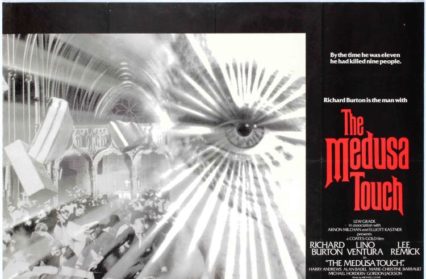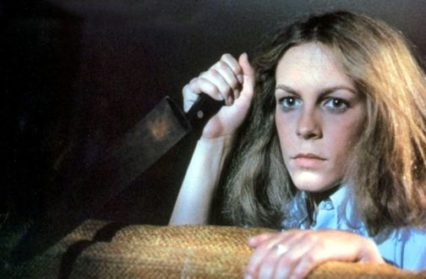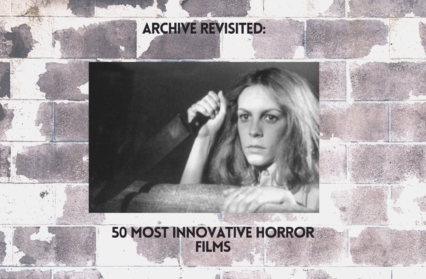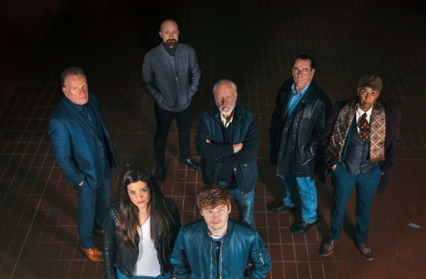The ‘Becoming Richard Burton’ / ‘Bywyd Richard Burton’ exhibition is now reopened at the National Museum Wales and Wales Arts Review is publishing a series of essays to run concurrently with the exhibition, curated by Daniel G. Williams, director of the Richard Burton Centre at Swansea University. Each essay will discuss a specific Burton film; this week, Alan Bilton considers The Medusa Touch.
Although rarely commented on today, the nineteen-seventies witnessed a spate of ‘psychic horror’ movies, starting with the forgettable Psychic Killer in 1975, before moving on to better known works such as Carrie (1976), Patrick (1978), and The Fury (1978), the cycle (arguably) reaching its apogee with David Cronenberg’s Scanners in 1981 (a second Stephen King adaptation, Firestarter, was a latecomer to the party in 1984). Publicity for these movies exploited a widespread public interest in Extra-Sensory Perception, telekinesis, spoon-bending and the like, these psychic feats occupying a distinctive space in the collective imagination. So-called ‘PK Parties’ (named after the pseudo-science of Psychokinesis) were a popular cultural fad during the period, party-goers yelling and screaming at the cutlery in their drawers in order to either twist them out of shape or levitate them across the room. Needless to say, the hysteria generated by such ritualised chanting and frantic bawling created an atmosphere of heightened suggestibility, but nevertheless many partygoers described the psychic liberation as life changing. Nor was such spoon-wrangling confined to swinger parties; the September 1976 edition of ESP magazine came emblazoned with the caption ‘THIS COVER CAN BEND YOUR KEYS’, and over three hundred readers wrote in to corroborate that the image had done just that. And who was in the picture? Why, none other than Uri Geller, a ubiquitous presence on US and UK chat shows during this period, copying pictures from viewers’ minds, starting stopped clocks, and warping tableware, all on primetime TV (Geller last appeared in the news in 2019, promising to prevent Britain’s exit from the EU by using his mind powers on Theresa May; sadly this proved no more successful than his attempt to help beleaguered football club Exeter City by burying energy filled crystal beneath Exeter’s goal before a vital match – Exeter lost 5-1) . But what lay behind the resurgence of this mysterious phenomenon? After all, such ideas had been in circulation for a very long time; the term ‘telekinesis’ had been coined as early as 1890 by the Russian ‘psychic researcher’, Alexander N. Asksakof, and was popularised by American author Henry Holt in his 1914 work, On the Cosmic Relations. Perhaps the answer lay in parallels between the late seventies and late nineteenth century fin-de-siecle mysticism. Just as the end of the nineteenth century witnessed a period of massive technological and industrial change – a new era of scientific rationality and efficiency – it also saw a diametrically opposed revival of interest in seances, ectoplasm, spirit photographs and levitation. In this context, one might be tempted to read this late seventies interest in occult or eldritch forces as a similar response to social unrest and uncertainty, a kind of compensatory spiritualism as a response to an overly mechanised age. With faith in both political and economic authority plummeting and the future looking increasingly uncertain, one can perhaps understand the desire to locate different sources of power and meaning, esoteric knowledge as a response to a Post-Nixonian world of conspiracy and paranoia, telekinesis unlocking secret reserves of energy with which to reanimate a post oil-crisis world.
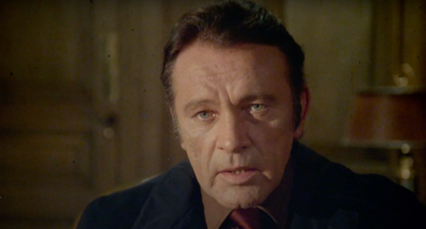
Looked at from this perspective, one can link the ‘psychic horror’ genre to better known trends in seventies genre cinema, from the cluster of films linked to the Satanic or occult, as exemplified by The Exorcist (1973) and The Omen (1976) to the cycle of disaster movies that encompassed everything from tidal waves to earthquakes to volcanoes to plane crashes. Indeed, in terms of its merger of all three of these genres, as well as its tone of nihilistic despair and shrill social critique, Jack Gold’s The Medusa Touch (1978) can be seen as a representative product of its time. It was Richard Burton’s second horror gig of the decade – following from the critical and commercial disaster of Exorcist II: The Heretic (1977) – and Burton’s strikingly sincere portrayal of melancholy rage and disheartenment has helped secure its reputation as a particularly strange and grim curiosity, its wild plot contrivances and clichés marinated in a bracingly bitter attack on hypocrisy, venality and mediocrity. Nominated by US critic Roger Ebert as ‘The Worst Film of 1978’, just like its mysterious anti-hero, the splenetic Morlar, The Medusa Touch continues to exert a strange influence from beyond the grave, from an unhappy link to 9/11, to the sampling of Morlar’s quote, “I will bring the whole edifice down on their unworthy heads” by The Manic Street Preachers on their 1998 track, Ready for Drowning (as well as a name check on their 2007 track, Leviathan, too). Both ridiculous and oddly unnerving, the film’s atmosphere of catastrophe and unceasing disaster seems oddly pertinent to our own times too, as if Morlar is still out there, plotting the next calamity: Chernobyl, Fukushima, the Wuhan wet market. For a frequently terrible movie, The Medusa Touch still disturbs.
“I have a gift for disaster,” intones Richard Burton’s melancholy novelist John Morlar near the start of the movie, though Burton might well have been talking about his career here instead. Alcoholism, money problems, contempt for the film industry, and a series of unwise film choices had left his reputation in tatters; nevertheless, Burton still commanded a fee of £500,000 for a mere three weeks filming that at times seemed more like voice over work than a leading role. With only a very small window before Burton was booked to fly to South Africa to make The Wild Geese (1978), Burton’s mellifluous (and maleficent) tones were carefully recorded, whilst a body double (who sadly doesn’t resemble Burton at all) was employed for the bulk of the movie where Morlar, sheathed in bandages, is consigned to a hospital bed. Nevertheless, in terms of his delivery, Burton remained sober and professional throughout the shoot, turning up on time and providing perfect line-readings throughout. Director Jack Gold – best known for his TV work, including The Naked Civil Servant (1975) – wanted Nicol Williamson for the role and was initially wary of the star’s notoriety, but Burton’s casting was required in order to attract funding and was deemed essential for publicity purposes. In order to secure European investment, the British detective of the novel was also changed to a visiting French inspector, played by veteran Italian/French actor, Lino Ventura, whose presence in London is explained as a kind of cultural exchange. In many ways though, Ventura’s role (much bigger in terms of screen time than Burton’s) works very well, his lugubrious expression and weary air of hard-won wisdom providing a visual echo of Morlar’s anguished features: both men have seen mankind at their worst, though their ethical responses prove very different. Likewise, Lee Remick, who took on the rather thankless role of Morlar’s therapist, Dr Zonfeld, in order to get the chance to work with Richard Burton, also mirrors Morlar in interesting ways, the film repeatedly stressing the piercing nature of their eyes via tight close ups of both Remick and Burton – which links to the use of ‘Medusa’ in the title, of course.
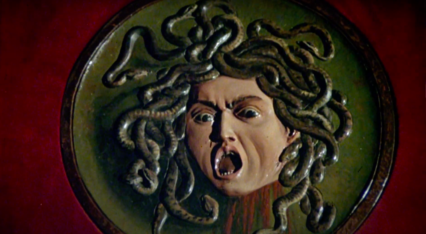
Bludgeoned almost to death by a mysterious assailant, Morlar’s presence in the film is thus confined to flash backs (or even flashbacks within flashbacks) or the conversations of others; essentially Ventura’s French cop, Brunel, spends the movie trailing around London meeting a series of veteran British character actors – Derek Jacobi, Michael Hordern, Harry Andrews, Gordon Jackson, and so on. For all this however, Richard Burton remains the dead centre of the movie, reciting a series of cynical diatribes against God, human nature, and the British establishment, his bile-filled invective delivered with what feels like a genuine frisson of rage and disgust. Anti-war (Morlar suggests burning down the Imperial War Museum), anti-capitalism, and proudly disrespectful of school, class and church, Morlar’s rage against the machine culminates in his attempt to crush the Queen, the government, and visiting foreign dignitaries beneath the ruins of the dubiously named Minster Cathedral – a punk nihilism in keeping with the Sex Pistol’s “God Save the Queen/The fascist regime” released the previous year.
The central conceit in all of this is that the misanthropic Morlar can ‘will’ disaster, causing ever greater misfortunes through the power of his mind. Beginning with ‘wishing’ his horrible nursery nurse to catch measles, Morlar then despatches his uncaring parents, sadistic teacher, feckless wife and even an overly loud neighbour, while the viewer (more or less) nods sagely in agreement. These deaths are generally portrayed in terms of slapstick black comedy, a peculiarly British delight in murder that recalls Kind Hearts and Coronets (1949) and The Lady Killers (1955), the surface cosiness offsetting a deeper sadism and repressed aggression. When Morlar’s psychiatrist refuses to believe him, suggesting that the belief is “delusional”, Morlar then causes a 747 to crash into a London tower block, a strikingly violent sequence whose Twenty First Century connotations are hard to avoid. Whilst Morlar’s earlier victims have all been, to a certain extent, deserving of psychic retribution, here we witness the death of hundreds of innocents – although since Morlar believes human nature to be irredeemably evil, this could well be a false differentiation. Nevertheless, at this point in the narrative our sympathy for the devil (“I am learning to admire the man more and more” notes Brunel earlier) dries up, and we turn against him just as he plots to wipe out the government – an attempt both grounded in the gunpowder plot of 1605 while also foreshadowing the Brighton bombing of 1984. Ultimately the movie repudiates Morlar’s nihilism while also taking enormous visual pleasure in the acts of violence: although the Queen escapes unscathed, the film delights in a ten-minute celebration of falling masonry, bloodied faces, crushed bodies and the like. Released with a ‘A’ Certificate by the British Board of Film Censors (the equivalent of a PG today), the film is strikingly brutal, glorifying in scenes of horror while simultaneously condemning them- a hypocrisy which Morlar himself would no doubt see as representative of our debased modern culture.

Considering the ripe old nature of such Grand Guignol style bloodletting, Richard Burton delivers his material with an unflinchingly straight bat. True, his terrifying stare which causes distress and unease in the recipient, is unfortunately reminiscent of Paddington (a fact not helped by Michael Hordern’s cameo), but otherwise the films’ stress upon his agonised features and sonorously sinister voice provides an emotional anchor in a film that otherwise teeters into absurdity. We believe in Morlar’s disgust with humanity, and the film makes us share in his loathing. Morlar the bitter artist blurs into our image of Burton at the stub end of his life; an atheist outraged with God, a critic of British Imperialism without believing in any alternative, a writer whose existential despair goes ignored by the masses. Despite his late casting, it is impossible to imagine any other actor in the role.
In terms of imagery, the film is, admittedly, hardly subtle. After a bland establishing shot, the opening sequence moves to a close up of Munch’s ‘The Scream’, before the opening credits play out over an image of Caravaggio’s Medusa. Aside from this visual reference, there is no other link to the films’ title other than repeated close ups of both Morlar and Zomfeld’s eyes – an obvious mirroring of victim and assailant. Otherwise, there is no clear link between the medusa myth in classical antiquity and either telekinesis or prophesising disaster. Instead, the medusa reference seems simply to denote the monstrous or the otherworldly; if anything, it is Burton, unsympathetically lit and frequently static, whose ruined features appear petrified, staring out of the screen like some baleful gargoyle, again mirroring the collapsing cathedral at the movie’s end.
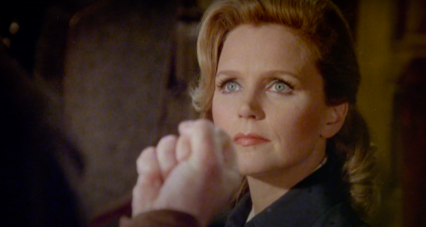
And yet for all this apparent irrelevancy, the medusa reference also suggests another way of reading the film. After all, the medusa myth suggests that some horrors are too awful to stare at directly: to gaze directly at the Gorgon is to die. Instead, Perseus triumphs by looking at the monster’s reflection in Athena’s shield, allowing him to advance ever closer to the source of ineffable evil. This myth in some ways acts as a kind of justification of the horror genre in toto. Some things are simply too traumatic or upsetting to approach directly; instead, they can only be approached via their image or reflection, which is to say, through symbols and imagery. Monsters are thus symbolic representations of the very things (illness, darkness, death) we fear the most, a way of sizing up what otherwise remains either socially prohibited or repellent. In this sense, both The Medusa Touch and the fad for psychic powers can be seen as symbolic representations of the deeper fears of the decade: that global events were slipping out of control, old patterns of belief and authority breaking down (symbolised by the fissure that erupts on the west transept of ‘Minster Cathedral’ in the film), the notion that Evil, rather than Good, is the principal rule governing human affairs. The telekinesis craze has thus much in common with conspiracy theories: the notion that the ‘true’ nature of events has been disguised or hidden, that power instead flows along unknown or invisible channels, events determined by unknown individuals working for baleful ends. Such notions are both despairing and yet oddly pleasurable, even comforting: there is a meaning out there, simply one hidden from the common sight. Ultimately Morlar’s demonic powers are in fact a form of malevolent wish fulfilment (amongst Freud’s unpublished papers was Das Medusenhaupt or ‘The Medusa’s Head’), the idea that reality can be made to conform to our secret desires and needs. By cultivating a delight in destruction and making us share in Morlar’s misanthropy, the film thus articulates both a fear of social collapse alongside the nihilistic longing to bring this carnage about. Ultimately the face in Athena’s mirror is our own.
Alan Bilton is the author of three novels, including The End of The Yellow House (Watermark, 2020) as well as a collection of short stories and books on silent film, contemporary fiction, and the 1920s. He teaches creative writing, literature and film at Swansea University.


